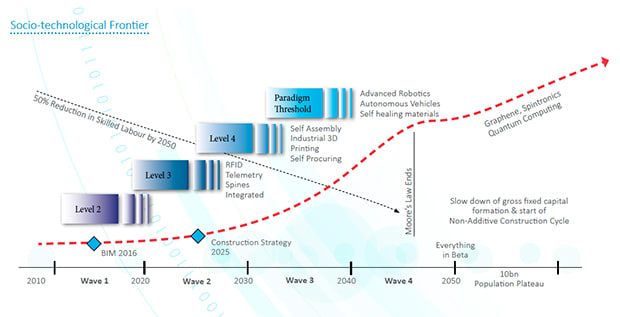The industry needs to wake up to the transformative impact of digital technologies on its operations and workforce, concludes a new report published yesterday by the Construction Industry Council’s BIM 2050 group.
And it suggests that younger professionals in the industry today will eventually work in a world that features advanced technologies such as “auto-procurement”, self-assembling structures and self-healing materials.
The BIM 2050 group of young professionals drawn from across the construction disciplines was convened by the CIC in January 2013, with a brief to “steer the sector towards a BIM-enabled future”. It is chaired by David Philp FCIOB, head of BIM implementation at the government’s BIM Task Group.
The report looks at the future evolution of the industry under three main themes: education and skills, process and technology, and culture and integration.
BIM 2050’s vice chair Neil Thompson ICIOB, principal BIM integrator at Balfour Beatty, highlighted four principal themes, starting with the mismatch between the expectations of the data-sharing generation entering the industry, and the highly territorial sector they find themselves in.
“Young people today habitually use the digital space and share information, but the danger is they come in and they’re alienated – the industry is still tribal and defensive. The industry needs to recognise that danger,” he said.
He also pointed to a dangerous gap between academia and industry practice. “The edge between academia and the industry needs to blur," he argued.
Second, he pointed out that IT and new technologies will make it easier for SMEs and subcontractors to take on project risks, for instance if they have access to accurate and transparent information via BIM. The effect could be to promote the creation of a larger number of small, specialist firms, rather than having the large contracting organisations that are traditionally viewed as the best way to deal with risk.
“Young people today habitually use the digital space, but the danger is they come in and they’re alienated – the industry is still tribal and defensive. The industry needs to recognise that danger.”
Neil Thompson ICIOB
Balfour Beatty
“In effect, it will lower the barriers for entry for start-ups and SMEs – people will use the technology to take on more risk.”
A third theme was the more intelligent use of “human capital”, enabled by better understanding of the strengths and weaknesses individuals bring to the workplace.
“We’re already seeing the Highways Agency doing behavioural assessments of the construction teams bidding to work with them,” said Thompson. “We think the industry will become a lot more aware of their ‘behavioural intelligence’, because building something is an incredibly collaborative experience.”
Finally, he pointed to the rise of robotics, mechanisation and autonomous vehicles, such as Google’s driverless cars, and the impact this technology would have on infrastructure.

The report slices the forthcoming 36 years into four segments. In the 2010-20 period, the industry is attempting to digitise the analogue and paper-based systems that have been entrenched for years; in 2020-30, it will start to adapt to become more technology-led, using RFID tagging and geo-information.
In 2030-40, it will embrace 3D printing, robotisation and mechanisation of the construction process, and in 2040-50 it will operate in a world of autonomous vehicles, self-healing materials and advanced robotics.
A diagram (above) illustrating these four “waves” of technological advancement, authored by Philp and Thompson, also indicates that by 2050, the industry’s workforce of skilled labour will be reduced to 50% of its 2013 level.
However, Thompson stressed that an equivalent number of new jobs would be created in the fields of robotics, coding, auditing and training. “We will need more people to deal with the education of people,” he predicted













